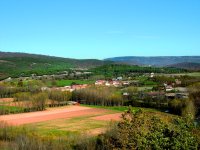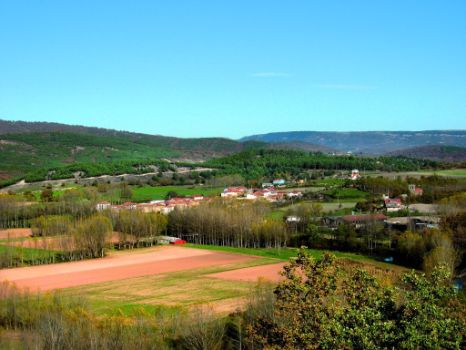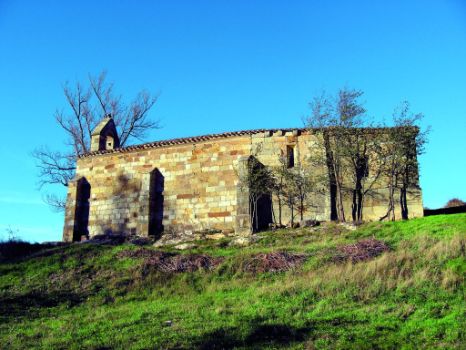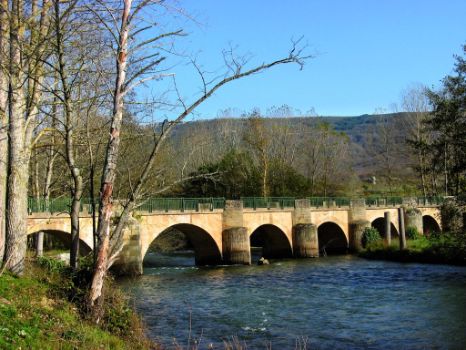Net of Natural
Trails

Stage 3: Villanueva de la Nía - Polientes
Description
Villanueva de la Nía (725 m) is home to the Romanesque church of San Juan Bautista, whose 12th century apse with corbels engraved with sexual motifs is attributed to the school of Cervatos. It also boasts traditional mountain-style houses, with solarium-galleries and façades showing semicircular arches, and the Via Crucis to the shrine of Nuestra Señora del Monte.
The route crosses Mardancho Brook and follows a track lined with gall oaks, through Mount La Nía, overlooking Cubillo de Ebro. Past a farm where the route has to cross two gates, the track begins to climb up Mount Casallo, with views of Berzosilla and the mountain range. After reaching the summit of Castillo Hill (840 m, 3.2 km, 55min), the route descends to the east, towards Cuillas Valley, through a gall oak forest (5 km, 1hr 30min). It leaves this town by a bridle road to Olleros de Paredes Rubias, through pastures and past an old fountain. The preserved medieval kilns and the name of the town, Olleros de Paredes Rubias, are reminiscent of the ceramics produced here. Worthy of note are its folk architecture and the Gothic church of San Juan Bautista.

The route heads first through flat fields then gall oak forests, to arrive at Sobrepenilla (7.8 km, 2hr 20min). At the edge of town, next to the 13th century Romanesque church of San Martín, with a belfry, marketplace and beautiful windows along the flat apse and the south wall, the route continues, through gall oaks, along a track to Sobrepeña that is situated to the right of a larger road, with views of Montecillo, Quintanilla de An, Campo de Ebro and other landscapes.
According to the date engraved on its façade, the church of Santa Juliana in Sobrepeña dates back to 1567. It also has a marketplace and a belfry with magnificent views of the surroundings. “La Cojura del Ebro”, a centre for rural development, is also noteworthy.

The route continues along the road for a short distance, and then turns right onto the path to Rebollar de Ebro through gall oaks. It comes upon the road and ventures again through a gall oak forest and fields. The path reaches a grass covered clearing, with the Ebro to the left and the shrine of Santa Mara in the distance. A road to the right (not part of the GR 99), leads to a Romanesque building with nineteenth century additions. It has a nave, a flat apse and small belfry. However, what is most interesting are the anthropomorphic tombs carved into the rock. Under the tombs, next to the path is the original cave shrine.
From here, the route follows the right bank of the Ebro to Rebollar (12.3 km, 3hr 35min), home to the 16th century Gothic church of San Vicente. It has a belfry, polygonal apse, lancet arch façade and several archivolts decorated with wooden balls under a wooden strip. Past the village, a trail to the right leads to a reforestation pine forest on a small hill.

The route continues along flat terrain with views of Polientes (710 m, 12.3 km, 3hr 35min) across the Ebro (right bank). Past the shrine of Velilla, and once back on the road, the route arrives at Rocamundo Bridge and a recreation area, from where it ventures into Requejada (16.6 km, 4hr 55min), capital of the municipality of Valderredible.
The town has fine examples of civil architecture, including the town hall (1930s), the tourism office and Valderredible Ethnographic Museum (former town hall damaged by fire in 1931), which showcases the history, customs and traditions of the area. The Environmental Education Centre organises events to raise schoolchildren's awareness of the area's natural and cultural heritage.
Entidades gestoras:
- Ministerio de Agricultura, Pesca y Alimentación
Enlaces de interés
Puntos de interés
Culture
Municipality
Profile






